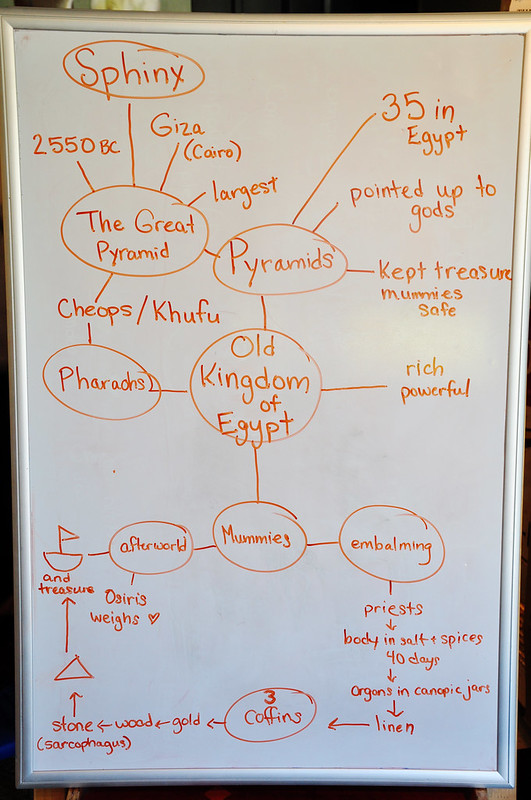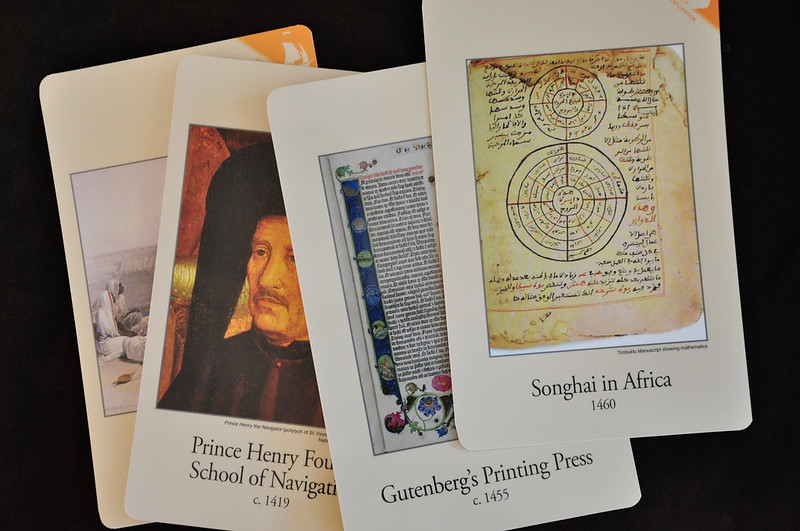Alternate title: Giving Structure to the Spaghetti
Back in November I began a curricula series, starting with The Great Conversation, the driving themes behind my curricula choices. I followed up with a list of my top core skill curricula for elementary in The Simplicity Version. Now I would like to dive into a more detailed list of favorite curricula and resources by subject, as well as give an idea of how we put those into action here at Mt. Hope.
The obvious starting place for us is history as the Ultimate Story that holds all people, places, events, ideas, discoveries—in essence, all of life.
Science, government, mathematics, exploration, art, geography, language, philosophy, commerce, architecture, inventions, agriculture, theater, religion, music, literature, and cultures are all woven into the one unfolding, chronological story of our world.
Susan Wise Bauer states in The Well-Trained Mind:
“[T]o the classical mind, all knowledge is interrelated…The world is full of knowledge, and finding the links between fields of study can be a mind-twisting task. A classical education meets this challenge by taking history as its organizing outline, beginning with the ancients and progressing forward to the moderns in history, science, literature, art, and music…
“This pattern lends coherence to the study of history, science, and literature — subjects that are too often fragmented and confusing. The pattern widens and deepens as the student progresses in maturity and learning.”
Subjects and information, whether memory work or stories or a documentary on t.v., instantly have context (or an established mental file-folder) when a student has a general grasp of the flow of history. For that reason, my first recommendation is the memorization of a basic history timeline. I specifically and enthusiastically recommend the Classical Acts and Facts History Cards from Classical Conversations. Paired with the Timeline Song, this resource makes the spread of human history accessible to young children.
Leif, my six year old, has a great portion of the timeline memorized. Luke, my eight year old, memorized it within a couple months of relaxed review. At the very least, seemingly difficult names of people, places, and events roll of their tongues with ease—and capture their attention when heard elsewhere—fostering familiarity and interest, and reducing intimidation. The cards are gorgeous and each contains brief information for added context. The song, unlike many educational songs, is catchy and enjoyable, even for adults. We have listened to it often for months on end, and it has yet to get on my nerves. The boys love it, and it makes memorization a cinch.
One reason that a full history timeline is my first recommendation is that history exposure doesn’t always come in a perfectly unfolding chronological package. Whether or not you begin history studies with the ancients when your child is in the first grade, he or she will most likely be introduced to other people, events, or ideas in moments outside of planned lessons. There is no reason to avoid books, documentaries, field trips, classes, discussions, current events, or performances just because they don’t fit neatly into your history schedule. And what about the second child who folds into family history studies during the medieval or modern period?
Image from Add-a-Century Timeline
There are many resources available for purchasing or creating a visual timeline. We haven’t been diligent with creating our own timeline at home, but this is a great way to gather content from various subjects into one place. I’m hoping to light a fire under myself to get our timeline put together, shrug off my perfectionistic tendencies, and have the boys help me choose and enter information from our memory work and general studies so that we have a visual representation of the course of history and integration of all subjects.
When we began Classical Conversations, I had no idea that the history sentences would enhance our history studies to the extent that we’ve experienced. As with the Classical Acts and Facts History Cards, the history sentences that the boys memorize each week are a huge bonus to our lessons. Quite simply, memorizing the songs before reading about the content in The Story of the World considerably improves their interest and retention—even when the stories are read months or years later. The songs are fun and catchy. Leif memorized them well at the age of four. The history sentences/songs are one of the boys’ favorite aspects of CC.
All of the Classical Conversations Foundations memory work for all three cycles, including the timeline events, are outlined in the Foundations Guide. Each cycle contains 24 short history selections (each 1-3 sentences long; a couple are lists). The history sentences in song form are included on the audio CDs which must be purchased individually for each cycle.
[An example of one of the history selections: “English King John signed the Magna Carta in 1215, limiting the king’s power. Later, England’s King Edward III claimed to be king of France and began the Hundred Years’ War in 1337.”]
The Story of the World series was mentioned in my Simplicity Version as my top recommendation for history for the elementary student. We are on our second trip through the four-volume series. I loved the narrative-style books the first time through, and I am enjoying them even more the second time around with a wider range of student ages. They are fabulous as a stand-alone resource or as a jumping-off place for additional reading and rabbit trails. The Story of the World easily can be supplemented for older students.
For all-in-one integrated lessons, The Story of the World Activity Books include corresponding history encyclopedia references, non-fiction, historical fiction, and literature book lists, map work, comprehension questions, sample narrations, coloring pages, crafts, and activities. I use the book lists extensively, but—much to my boys’ dismay—rarely get around to the projects and crafts. (Sigh. Not a super-mom in this department, for sure.)

The boys and I have been practicing our note-taking skills while reading selected chapters from The Story of the World. We stop every paragraph or two and review the most important or interesting facts. I write on the white board, and they copy the notes down on their own paper. We turn these notes into a few sentences which we write on notebooking pages and add to our 3-ring history binders. This is about as far as I’ve gotten to tying in The Story of the World directly with writing, and we don’t do it for every chapter. I’ll talk more about writing a bit further into the curricula series.
The Story of the World gives us a basic outline for history topics, but rarely do we stop there. At any given time our house (and car) is littered with history books, both non-fiction and historical fiction. I check the upcoming topics and pull books off our shelves as well as put books on hold at the library. The selections range from simple picture books to more difficult chapter books. Each of my boys read what they are capable of reading. For Levi, that means every book I can find on the subject, simple to complex. Luke reads the picture books and simple chapter books. Leif reads whatever sparks his interest.
For example, at the moment we are studying ancient history—more specifically, (early) ancient Greece. A sample of the books on the toppling stacks are:
The Librarian Who Measured the Earth by Kathryn Lasky, a gorgeous picture book with a surprising amount of information about the Greek scholar Eratosthenes (blurring the lines between history, science, and math). This book is a favorite of mine.
The Minotaur of Knossos by Roberta Angeletti, a fun picture book about a modern boy who falls asleep reading about King Minos and the Minotaur, wakes up among the ruins of Knossos, and meets Sir Arthur Evans, the archaeologist who discovered the palace of Minos.
The Hero Schliemann: The Dreamer Who Dug For Troy by Laura Amy Schlitz, a simple chapter book about a German man who fell in love with Homer’s epic poetry and set off on a lifelong quest to find the lost city of Troy.
Magic Tree House Fact Tracker #10: Ancient Greece and the Olympics: A Nonfiction Companion to Magic Tree House #16: Hour of the Olympics by Mary Pope Osborne and Natalie Pope Boyce.
Archimedes and the Door of Science by Jeanne Bendick from the Living History Library series, a chapter book again blurring the lines between history, science, and math.
Occasionally we also have more weighty historical fiction selections, which are read primarily by Levi. On the list for the coming months are The Bronze Bow by Elizabeth George Speare, Ben-Hur: A Tale of the Christ by Lew Wallace, and Julius Caesar by Shakespeare among others.
I could list favorite history-related books (especially picture books) all day long. I’m fairly certain this is one of my favorite things about homeschooling!
Our current historical literature stack is a fun one with Greek myths and Homer, but we’ll get to literature a couple posts down the road.
Another book currently on “the stack” is the first book in the new historical fiction series from Veritas Press, Pages of History Volume 1: Secrets of the Ancients. It covers history from Creation to the Reformation (with a Christian world view) in a time-travel adventure. Levi and Luke both devoured all 438 pages within a day or two. Luke immediately wanted to get the next volume. I told him he would be waiting a while…

The boys also enjoy reading through the history encyclopedias we keep handy. I often assign specific pages to correspond with our history topic, but rarely do they stop at just a couple pages. Luke loves The Usborne Encyclopedia of World History, and The Kingfisher History Encyclopedia is at a slighter higher level which is perfect for Levi.
As if that list isn’t quite long enough, we occasionally watch related documentaries or internet videos, as well.
Music of History - Ancient Egypt from Music of History on Vimeo.
While these resources make up the base or “spine” of our history studies, threads of history appear in every other subject.
Next up: Geography
(This post does contain affiliate links. I receive a small commission for purchases made through the links. I am so appreciative of those of you who have helped support Mt. Hope Chronicles! Thank you!)





7 comments:
If you like doing mindmaps, try Popplet
Do you use vimeo frequently? I've only looked in youtube. . . I forget about vimeo. so great to have those visuals for all the history. Thanks for this write up. I totally agree.
Danielle~ I usually use YouTube. Occasionally I'll come across a link for vimeo (such as on Pinterest), but I don't use it when I'm searching for videos on a topic.
I have a 5 & 6 year old in CC this year, our first year - do you tend to follow the 3 year history cycle of CC or the 4 year cycle mapped out by the Well Trained Mind. My main sources of curriculum structure are CC mixed with TWTM. I guess I'm just looking for opinions on what works. Classical education is beautiful but sometimes I'm overwhelmed.
I have to endorse the timeline song as well ... it's amazing how often we're reading about or discussing something (or learning a new history sentence) and just by singing a snippet of the song, we place it in context. It helps me personally all the time! :-)
You know that was me, too. Just assume any comments from Ian are actually me. That's just life when you share a computer with a 12 year old who signs in and out of his Google account at least twice a day! ;-)
- Hannah
Just purchased the Mp3 of Cycle 1 Ancient Civilizations per your suggestion. I continue to go over memory work with the boys. Thanks! Great post!
Post a Comment